17. Linked lists¶
One of the more interesting qualities of an object is that an object can contain a reference to another object of the same type. There is a common data structure, the linked list, that takes advantage of this feature.
Linked lists are made up of nodes, where each node contains a pointer to the next node in the list. In addition, each node contains a unit of data we will call the cargo. In our first example, the cargo will be a single integer, but later we will write a generic data structure that can contain objects of any type.
17.1. Nodes¶
As usual when we write a new object, we’ll start with the instance variables,
one or two constructors and to_str so that we can test the basic mechanisms
of creating and displaying the new type.
struct Node {
int cargo;
Node* next;
Node() {
cargo = 0;
next = nullptr;
}
Node(int cargo) {
this->cargo = cargo;
next = nullptr;
}
Node(int cargo, Node* next) {
this->cargo = cargo;
this->next = next;
}
string to_str() const {
return to_string(cargo);
}
};
The declarations of the instance variables follow naturally from the
specification, and the rest follows machanically from the instance variables.
We should also note that we are intentionally using struct instead of
class, so that our instance variables are public by default (see
What is a class?).
To test the implementation so far, we would put something like this in
main:
Node* node1 = new Node(1, nullptr);
cout << node1->to_str() << endl;
The result is simply:
1
To make it interesting, we need a list with more than one node!
Node* node1 = new Node(1, nullptr);
Node* node2 = new Node(2, nullptr);
Node* node3 = new Node(3, nullptr);
This code creates three nodes, but we don’t have a list yet because the nodes are not linked. The state diagram looks like this:
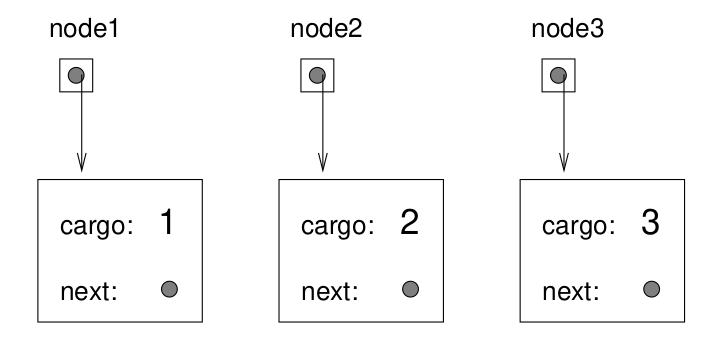
To link up the nodes, we have to make the first node refer to the second, and the second node refer to the third.
node1->next = node2;
node2->next = node3;
The next variable of node3 is still nullptr, which indicates it is
the end of the list. Now the state diagram looks like:
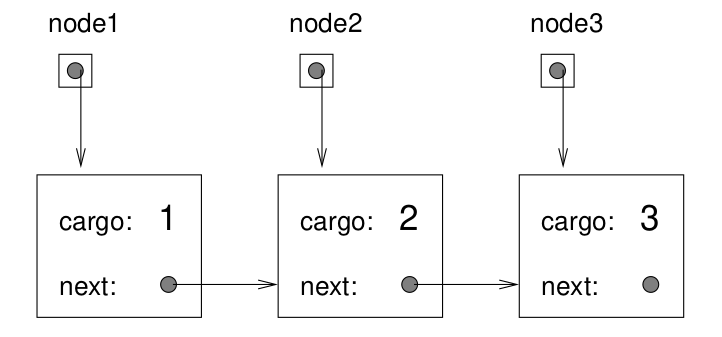
Now we know how to create nodes and link them into lists. What might be less clear at this point is why. We’ll take that up in the next section.
17.2. Lists as collections¶
The thing that makes lists useful is that they are a way of assembling multiple objects into a single entity, sometimes called a collection. In this example, the first node of the list serves as a pointer to the entire list.
If we want to pass the list as a parameter, all we have to pass is a pointer to the first node, as in the following function:
string render_list(Node* list) {
Node* node = list;
string s = "";
while (node != nullptr) {
s += node->to_string();
node = node->next;
if (node != nullptr)
s += ", ";
}
return s;
}
We can now call this function, passing it a pointer to the first node in our list:
cout << render_list(node1);
Inside render_list we have a pointer to the first node of the list, but
there is no variable that refers to the other nodes. We have to use the next
value from each node to get to the next node.
This diagram shows the value of list and the values that node takes
on:
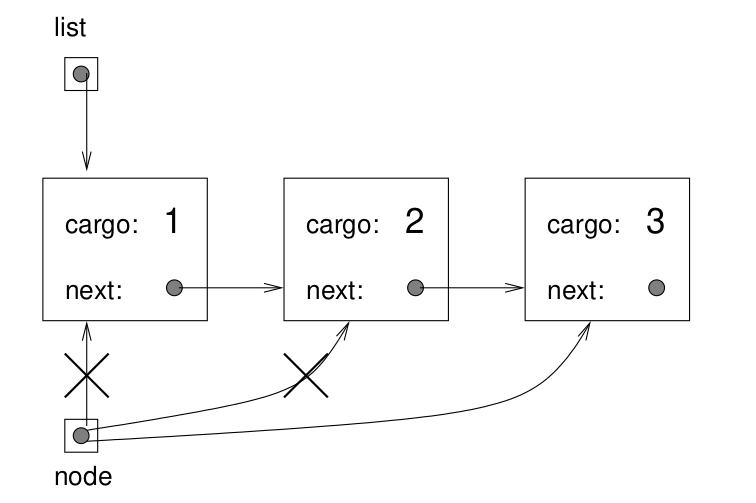
This way of moving through a list is called a traversal, just like the similar pattern of moving through the elements of a vector. It is common to use a loop variable like node to point to each of the nodes in the list in succession.
The output of this function is:
1, 2, 3
17.3. Lists and recursion¶
Recursion and lists go together like fava beans and a nice Chianti. For example here is a recursive algorithm for rendering a list backwards:
Separate the list into two pieces: the first node (called the head) and the rest (called the tail).
Render the tail backwards.
Render the head.
Of course, step 2, the recursive call, assumes that we have a way of rendering a list backwards. But if we assume that the recursive call works – the leap of faith – then we can convince ourselves that this algorithm works.
All we need is a base case, and a way of proving that for any list we will
eventually get to the base case. A natural choice for the base case is a list
with a single element, but an even better choice is the empty list, represented
by nullptr.
string render_list_backward(Node* list, string s) {
if (list == nullptr) return "";
Node* head = list;
Node* tail = list->next;
s = render_list_backward(tail, s) + s;
if (head->next != nullptr)
s += ", ";
s += head->to_string();
return s;
}
The first line handles the base case by doing nothing. The next two lines split the list into head and tail. The next line makes the recursive call to render the tail backward, and the three lines after that render the head.
Take a minute to think about why we have the if statement that adds ",
" before the line that renders cargo. If you understand this, you are
well on your way to developing your recursive intution.
To be able to call this function exactly as we did render_list, we use make
s a default argument like we did in
Our own find function. We set the default value in the function prototype in the
header file:
string render_list_backward(Node*, string="");
so that we can call it without passing in a value for s:
cout << render_list_backward(node1);
The result is a backward list:
3, 2, 1
Can we prove that this function will always terminate? In other words, will it always reach the base case? In fact, the answer is no. There are some lists that will make this function crash.
17.4. Infinite lists¶
There is nothing to prevent a node from pointing back to an earlier node in the list, including itself. For example, this figure shows a list with two nodes, one of which points to itself.
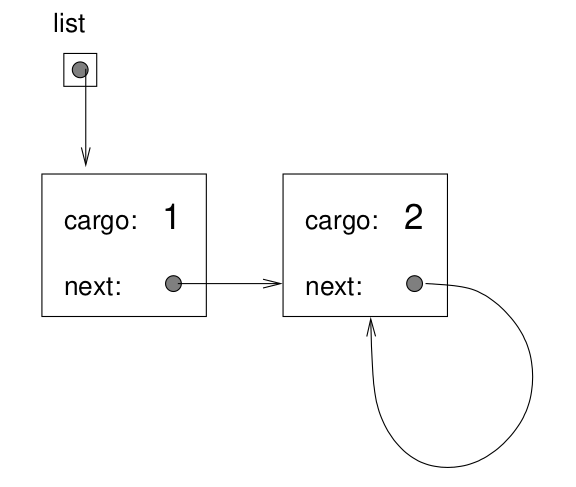
If we call either render_list with this list as an argument, it will loop
forever. If we call render_list_backward it will recurse infinitely. This
sort of behavior makes infinite lists difficult to work with.
Nevertheless, they are sometimes very useful. For example, we might represent a number as a list of digits and use an infinite list to represent a repeating fraction.
Regardless, it is problematic that we cannot prove that render_list and
render_list_backward terminate. The best we can do is the hypothetical
statement, “If the list contains no loops, then these functions will
terminate.” This is another example of a precondition, to which we were
introduced in the Preconditions section of an early chapter. As with the
earlier example, it imposes a constraint on one of the parameters and describes
the behavior of the function if the constraint is satisfied. We will see more
examples of this soon.
17.5. The fundamental ambiguity of lists¶
There is a part of render_list_backward that might have raised an eyebrow:
Node* head = list;
Node* tail = list->next;
After the first assignment, head and list have the same type and the
same value. So why did we create a new variable?
The reason is that the two variables play different roles. We think of head
as a pointer to a single node, and we think of list as a pointer to the
whole list. These “roles” are not part of the program; they are in the mind of
the programmer.
This ambiguity is useful, but it can make programs with lists difficult to
read. It is a good practice to use variable names like node and list
to communicate how we intend to use them. Such self-documenting code is
easier to read and easier to maintain.
We could have written render_list_backward without head and tail,
but it makes it harder to understand:
string render_list_backward(Node* list, string s) {
if (list == nullptr) return "";
s = render_list_backward(list->next, s);
if (list->next != nullptr)
s += ", ";
s += list->to_string();
return s;
}
Looking at the two function calls, we have to remember that
render_list_backward treats its argument as a list and to_string treats
it as a single node.
Always keep in mind the fundamental ambiguity of lists:
A variable that points to a node might treat the node as a single object or as the first in a list of nodes.
Note
See page 223 of the 1957 paper Programming the Logic Theory Machine by Allen Newell and John Clifford Shaw, where lists are defined with:
A list consists of an ordered set of items of information. Any item on a list may be either a list or an element, and these are fundamentally different types of units…
17.6. Member functions for nodes¶
You might have wondered why we didn’t write render_list and
render_list_backward as member functions of Node. We said back in
Objects and functions that any free-standing function taking an object
as an argument could also be written as a member function of that object. It’s
just a question of which form is cleaner.
In this case there is a legitimate reason to choose free-standing functions.
It is legal to send a nullptr as an argument to a free-standing function,
but it is not legal to invoke a member function on a nullptr object.
Node* node = nullptr;
render_list(node); // legal
node.render_list(); // WRONG! - Segmentation fault (core dumped)
This limitation makes it awkward to write list-manipulating code in a clean, object-oriented style. A little later we will see a way to get around this.
17.7. Wrappers, helpers, and function pointers¶
For some operations it is useful to divide the labor into two functions. For
example, we can render a linked list forward with render_list, and backward
with render_list_backward, and in each case we may want to “pretty print”
the list in the conventional format, enclosed in parenthesis, giving us
(1, 2, 3) and (3, 2, 1).
Rather than violating the DRY principle by implementing this pretty printing
twice, let’s create a wrapper function named render_pretty that
has a list and a function pointer as parameters.
string render_pretty(Node* list, string (*list_renderer)(Node*)) {
return "(" + list_renderer(list) + ")";
}
The syntax for creating a pointer to a function is:
RETURN_TYPE (*FUNCTION_POINTER_VARIABLE_NAME)(FUNCTION_PARAMETERS)
This wrapper function is an example of what is called a helper function, since breaks down the parts of a computation (in this case, adding parenthesis and rendering the list) into separate functions which can be reused.
We can now call render_pretty with the address of the function
render_list as an argument.
render_pretty(node1, &render_list);
When we run this we get:
(1, 2, 3)
Unfortunately, we can’t just send render_pretty the address of
render_list_backward because the signature doesn’t match - it requires a
string argument. To fix this, we can rename render_list_backward to
render_backward_worker and then make render_list_backward a
wrapper function that calls it with an empty string:
string render_list_backward(Node* list)
{
return render_backward_worker(list, "");
}
17.8. Modifying linked lists¶
One obvious way to modify a linked list is to change the cargo of one of its nodes, but the more interesting operations are the ones that add, remove or reorder the nodes.
As an example, we’ll write a function that removes the second node in the list and returns a pointer to it.
Node* remove_second(Node* list) {
Node* first = list;
Node* second = list->next;
// make the first node point to the third
first->next = second->next;
// remove the second node from the list and return a pointer to it
second->next = nullptr;
return second;
}
We are again using temporary variables to make the code more readable.
Warning
Here be dragons!
Care must be taken here not to leak memory, as we discussed in the Dynamic memory allocation and memory leaks section. If the return value from this function is not assigned to a variable by the caller, the memory used for the second node will be leaked.
Adding these lines to a main function will enable us to test it:
cout << render_list(node1) << endl;
Node* second_node = remove_second(node1);
cout << render_list(second_node) << endl;
cout << render_list(node1) << endl;
Giving us the output:
1, 2, 3
2
1, 3
Here is a state diagram showing the effect of this operation.
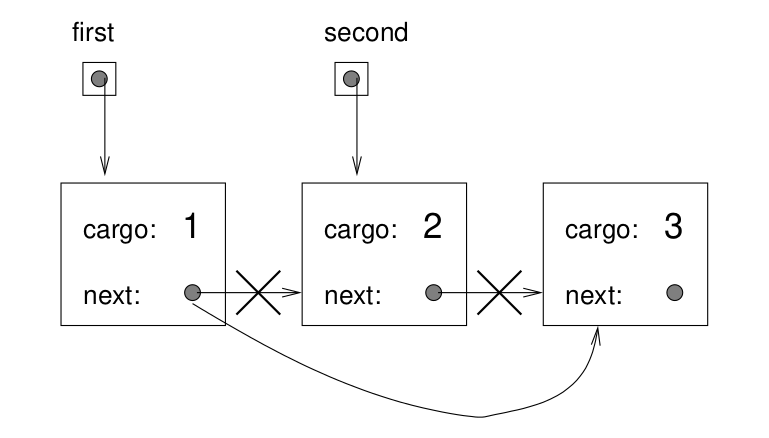
What happens if we call this function with a list with only one element (a singleton)? What happens if we pass it an empty list? Should there be a precondition for this function? You’ll be asked to handle these two cases as an exercise.
17.9. The LinkedList class¶
There are a number of subtle problems with the way we have been implementing
linked lists. The biggest one is the problem we encountered in
Member functions for nodes when we considered adding the render
functions as member functions to Node.
We can solve this problem by wrapping Nodes in a LinkedList class.
class LinkedList
{
int num_nodes;
Node* head;
public:
LinkedList() {
num_nodes = 0;
head = nullptr;
}
};
The LinkedList class gives us a natural place to put member functions,
like the following, that adds a new Node to the front of the list:
void LinkedList::insert_at_front(int cargo) {
Node* front = new Node(cargo, head);
head = front;
num_nodes++;
}
You will be asked to develop this LinkedList class further in the
exercises.
Next we will generalize it so that it can be used with different types of data.
17.10. Templates¶
One drawback of our LinkedList implementation is that the data (stored in
the cargo instance variable of Nodes) is limited to a single type,
int in our present case, even though it probably occurred to you that we
might want linked lists with various types of data.
While we could implement a different linked list class for each data type, this would be tedious, and it would violate the DRY principle we discussed earlier.
Fortunately, C++ provides class templates, which give us a solution to this problem.
Templates provide a way to specify linked lists as a generic data structure, meaning they can hold a
variety of data types. Using templates on our Node class looks like this:
template <class T>
struct Node
{
T cargo;
Node<T>* next;
Node(T cargo, Node<T>* next)
{
this->cargo = cargo;
this->next = next;
}
};
We begin with a new keyword, template, followed by <class T>, where
T represents the datatype that will be used to instantiate the templated
class. So our instance variable, cargo is given datatype T, and the
next pointer is declared to point to a Node<T>.
We can repeat the process of creating an explicitely linking together three
nodes and than printing out their contents, this time with nodes containing
string data, in a file named test_templated_nodes.cpp:
#include <iostream>
#include <string>
#include "LinkedList.h"
using namespace std;
int main()
{
Node<string>* node1 = new Node<string>("I", NULL);
Node<string>* node2 = new Node<string>("love", NULL);
Node<string>* node3 = new Node<string>("templates!", NULL);
node1->next = node2;
node2->next = node3;
Node<string>* node = node1;
while (node != NULL) {
cout << node->cargo << endl;
node = node->next;
}
return 0;
}
The next step is to use templating for our new LinkedList class.
template <class T>
class LinkedList
{
int num_nodes;
Node<T>* head;
public:
// constructor
LinkedList() {
num_nodes = 0;
head = nullptr;
}
// modifiers
void insert_at_front(T cargo) {
Node<T>* front = new Node<T>(cargo, head);
head = front;
num_nodes++;
}
T remove_from_front() {
if (head == nullptr)
throw runtime_error("Can't remove from empty list!");
T cargo = head->cargo;
Node<T>* front = head;
head = head->next;
delete front;
num_nodes--;
return cargo;
}
};
The instance variable head now points to the templated node, Node<T>*,
as do the nodes we create in insert_at_front and remove_from_front. We
are careful to free up the released memory in remove_from_front using the
delete operator, as we discussed in Dynamic memory allocation and memory leaks. To do this we need
to make use of a temporary variable, front. It points to the old head after
we advance head to next, so we can then delete it.
We also have to decide what to do when remove_from_front is called on an
empty list. For now, we are using the C++ throw command to report an
error. This will cause the program to halt, so client code should take pains
to avoid calling remove_from_front on an empty list. We’ll discuss this
further in the Exceptions section next chapter.
A more complete listing of code for this class is given in Appendix A: Code Source, including another constructor, and member functions to return its length and render it as a string. You will be asked to add several additional member functions to it in the exercises.
17.11. Invariants¶
Some linked lists are “well-formed,” others are not. For example, if a list
contains a loop, it will cause many of our functions to crash, so we might
want to require that lists contain no loops. Another requirement is that the
num_nodes value in a LinkedList object should be equal to the actual
number of nodes in the list.
Requirements like these are called invariants because, ideally, they should be true of every object all the time. Specifying invariants for objects is a useful programming practice because it makes it easier to prove the correctness of code, check the integrity of data structures, and detect errors.
One thing that is sometimes confusing about invariants is that there are some
times when they are violated. For example, in the middle of
insert_at_front, after we have added the node, but before we have
incremented num_nodes, the invariant is violated. This kind of violation is
acceptable; in fact, it is often impossible to modify an object without
violating an invariant for at least a little while. Normally the requirement is
that every function that violates an invariant must restore the invariant
before it finishes.
17.12. Glossary¶
- linked list¶
A data structure that implements a collection using a sequence of linked nodes.
- node¶
An element of a list, usually implemented as an object that contains a pointer to another object of the same type.
- cargo¶
An item of data contained in a node.
- link¶
A pointer to a node embedded in a node.
- generic data structure¶
A kind of data structure that can contain data of any type.